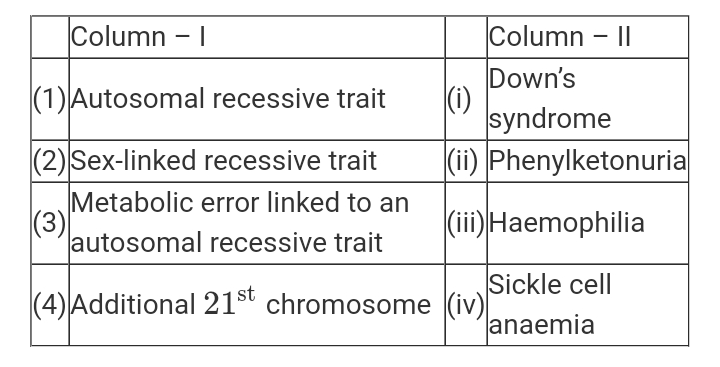Match column-i with column-ii using the code given below. [{column-i (substance) (a) dead bumt plaster, (b) gypsum, (c) slaked time, (d) plaster of paris} {column-ii (formula) (i) 2CaSO4,H2O, (ii) Ca(OH)2, (iii) CaSO4,2H2O, (iv) CaSO4
(a)(iv), (b)(i), (c)(ii), (d)(iii)
(a)(i),(b)(iii),(c)(iv),(d)(ii)
(a)(iii),(b)(ii),(c)(iv),(d)(i)
(a)(iv),(b)(iii),(c)(ii),(d)(i)
To solve the problem of matching the substances in Column-I with their respective formulas in Column-II, we will analyze each substance and identify its chemical formula step by step.
1. Identify the first substance: Dead Burnt Plaster
- Dead burnt plaster is known as anhydrous calcium sulfate.
- The chemical formula for dead burnt plaster is CaSO₄.
2. Identify the second substance: Gypsum
- Gypsum is the mineral form of calcium sulfate dihydrate.
- The chemical formula for gypsum is CaSO₄·2H₂O.
3. Identify the third substance: Slaked Lime
- Slaked lime is also known as calcium hydroxide.
- The chemical formula for slaked lime is Ca(OH)₂.
4. Identify the fourth substance: Plaster of Paris
- Plaster of Paris is calcium sulfate hemihydrate.
- The chemical formula for plaster of Paris is CaSO₄·(1/2)H₂O or equivalently CaSO₄·1.2H₂O. This can also be represented as CaSO₄·(H₂O) when considering the hemihydrate form.
Matching with Column-II:
Now we will match the identified formulas with those in Column-II:
- (a) Dead Burnt Plaster matches with (iv) CaSO₄.
- (b) Gypsum matches with (iii) CaSO₄·2H₂O.
- (c) Slaked Lime matches with (ii) Ca(OH)₂.
- (d) Plaster of Paris matches with (i) CaSO₄·(1/2)H₂O or CaSO₄·1.2H₂O.
Final Matching:
- (a) → (iv)
- (b) → (iii)
- (c) → (ii)
- (d) → (i)
Summary of Matches:
- A → iv
- B → iii
- C → ii
- D → i
- Dead burnt plaster is known as anhydrous calcium sulfate.
- The chemical formula for dead burnt plaster is CaSO₄.
- Gypsum is the mineral form of calcium sulfate dihydrate.
- The chemical formula for gypsum is CaSO₄·2H₂O.
- Slaked lime is also known as calcium hydroxide.
- The chemical formula for slaked lime is Ca(OH)₂.
- Plaster of Paris is calcium sulfate hemihydrate.
- The chemical formula for plaster of Paris is CaSO₄·(1/2)H₂O or equivalently CaSO₄·1.2H₂O. This can also be represented as CaSO₄·(H₂O) when considering the hemihydrate form.
- (b) Gypsum matches with (iii) CaSO₄·2H₂O.
- (c) Slaked Lime matches with (ii) Ca(OH)₂.
- (d) Plaster of Paris matches with (i) CaSO₄·(1/2)H₂O or CaSO₄·1.2H₂O.
- (b) → (iii)
- (c) → (ii)
- (d) → (i)
- A → iv
- B → iii
- C → ii
- D → i
Similar Questions
Match Column-I with Column-II and select the correct answer using the code given below the Columns

View SolutionMatch the compounds given in Column-I with Column-II and select the suitable option using the code given below

View SolutionMatch the important chemical given in column (A) with the chemical fomulae given in Column (B).
Column (A), Column (B)(a) Plaster of paris, (i)Ca(OH)2(b) Gypsum (ii)CaSO4.12H2O(c) bleaching powder (iii)CaSO4.2H2O(d) Slaked lime (iv)CaOCl2
View SolutionThe chemical formula of plaster of paris is CaSO4.2H2O
View SolutionMatch Column - I with Column - II and select the CORRECT option from the codes given below.

(a) 1 - (ii), 2 - (i), 3 - (iv) , 4 - (iii)
(b) 1 - (iv), 2 - (i), 3 - (ii) , 4 - (iii)
(c) 1 - (iv), 2 - (iii), 3 - (ii) , 4 - (i)
(d) 1 - (iii) , 2 - (iv), 3 - (i) , 4 - (ii)
View SolutionMatch List-I with List-II for the composition of substances and select the correct answer using the code gives below the lists:-
List−IList−IISubstancesComposition(A)Plaster of Paris(i)CaSO4.2H2O(B)Epsomite(ii)CaSO4.12H2O(C)Kieserite(iii)MgSO4.7H2O(D)Gypsum(iv)MgSO4.H2O(v)CaSO4
View SolutionThe formula of gypsum and plaster of paris are CaSO4.XH2OandCaSO4.Y2H2O respectively. Find the value of x+y.
View SolutionMatch Column -I with Column -II select the correct option from the codes given below .
Column -I (Scientific name )Column -II (Common name )(a)Chelone (i)Turtle (b)Testudo(ii)Tortoise(c)Calotes(iii)Tree lizard(d)Chamaelon(iv)Garden lizard
View SolutionMatch column I with column II and select the correct option from the codes given below.
columnIcolumnIIA.Natural auxin(i)NAAB.Synthetic auxin(ii)ZeatinC.Bakane disease of rice(iii)IAAD.Natural cytokinin(iv)GA(v)Kinetic
View SolutionMatch column with column II and select the correct option from
codes given below.
Column IColumn IIA. Brassica(i) HmigiriB. Okra(ii) Pusa KomalC. Wheat(iii) Pusa GauravD. Cowpea(iv) Pusa Sawani
View Solution